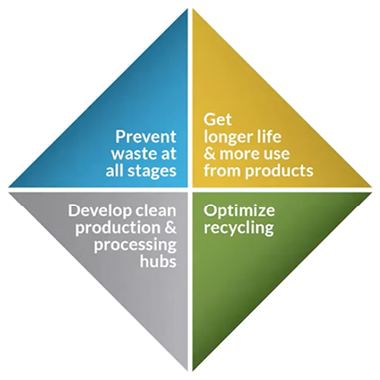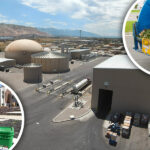The Center for Sustainable Infrastructure (CSI) released a blueprint for transforming the Pacific Northwest’s waste system into “a world-class model that delivers widespread economic, health and environmental benefits.” From Waste Management to Clean Materials details a clear pathway that can create tens of thousands of clean materials jobs across the region by 2040. The starting point for the blueprint is the intensifying crisis facing solid waste management. “At least four big challenges are driving transformation of the waste sector — the failure of waste prevention strategies to actually prevent much waste; the collapse of markets for recycled materials; radical changes in packaging and other waste stream components; and a new recognition that most damage to the planet and our health happens before, rather than after, our stuff becomes waste,” explains Rhys Roth, CSI’s executive director.
The report focuses on four Clean Materials solutions that work together like the interconnected facets of a diamond, rather than the traditional solid waste management hierarchy that ranks one above the other:
- Prevent waste at all stages by incentivizing redesign of products and supply chains to shrink carbon footprints, eliminate toxic materials, waste less food and conserve resources.
- Get longer life and more use from products through tool libraries, and with services like car-share, reuse and repair.
- Optimize recycling, which happens by cleaning up recycled material streams, ensuring ease-of-recycling in product design decisions, redesigning collection and processing of recyclables, and measuring success based on actual recycling.
- Create jobs at clean production and processing hubs. Used products and materials find new life through reuse, repair and recycling enterprises; co-located industries connect so one’s “waste” becomes another’s resource, saving materials, energy and water; and wastewater treatment plants grow into value-generating “biorefineries.”
“Today’s solid waste management framework is not well-suited to solve today’s challenges — or tomorrow’s,” says Roth. “We need a broader framework that moves up the value and supply chains, where most waste is generated and most damage to human health and the environment originates. It is here that we can design out waste, design for reuse or recycling, and avoid unnecessary costs and harm in the first place.”
The Clean Materials blueprint also proposes a core metric to measure progress — the Clean Score — built on the emerging science of life cycle assessment. Transparency of life cycle impacts, specific to each product, will create essential information needed to easily see which options are best for people and the environment. “We recommend that the initial version of Clean Score center on scoring the climate footprint of products, along with a toxicity 5-point color scale — best-to-worst gradations of green-yellow-red,” he adds. “Products that attain a good clean score for climate and a low-toxics footprint will tend to do well in reducing other environmental impacts as well.”













